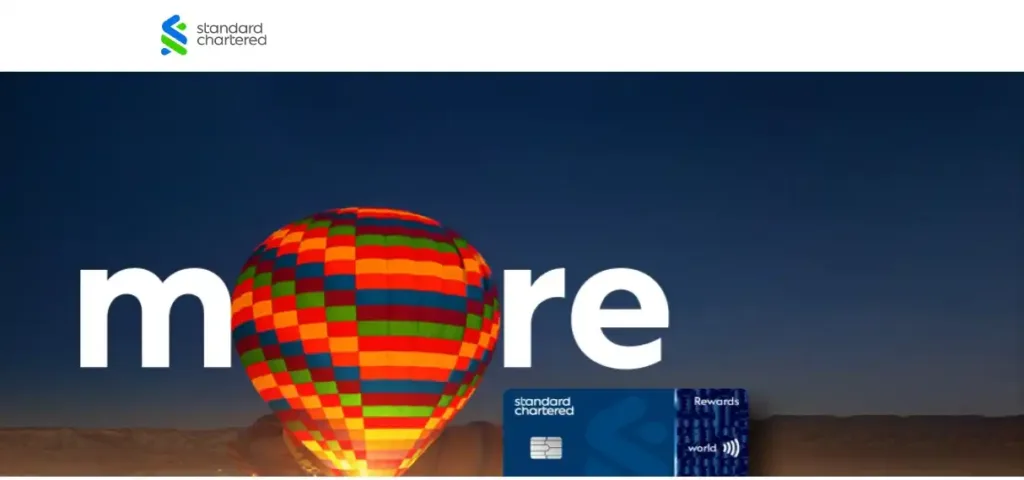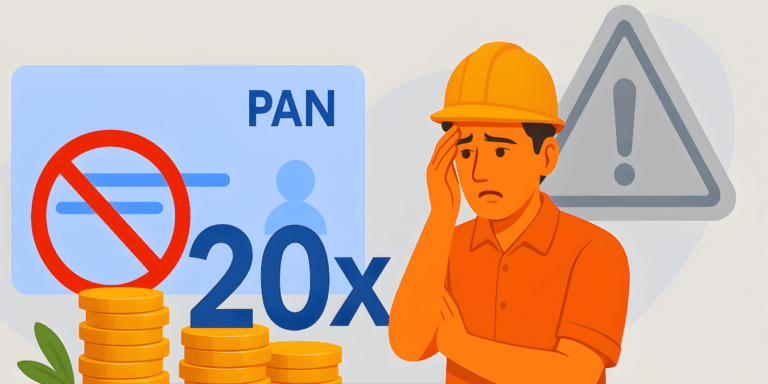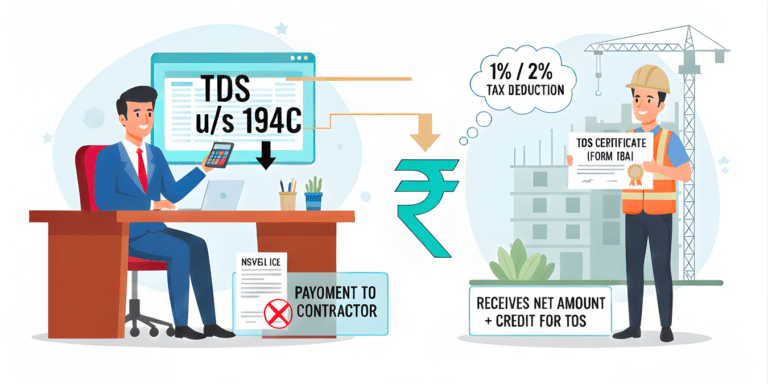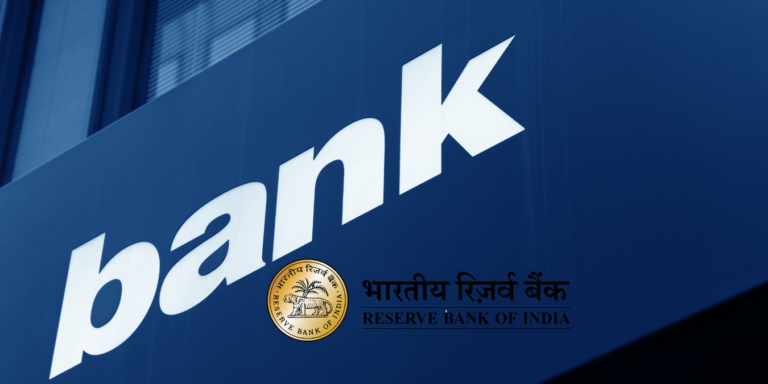
TDS on Salary: Section 192 Unveiled! Your paycheck’s shrinking, but why? Dive into the suspenseful world of TDS on Salary under Section 192, where 2025 updates bring shocking new slabs, higher exemptions, and hidden traps. Could you save thousands or lose big?
You are eagerly awaiting your monthly paycheck, only to find a chunk mysteriously vanished. No banking glitch, no sneaky thief—it’s TDS on Salary under Section 192 of the Income Tax Act. But what if this routine deduction hides a labyrinth of surprises, exemptions, and 2025 updates that could dramatically alter your take-home pay? Buckle up as we dive into the suspenseful world of TDS on Salary 2025, revealing curiosity-sparking facts, the latest data, and TDS calculation, Section 192 rules, and Income Tax Act provisions. By the end, you’ll be armed with knowledge to turn tax woes into wins, potentially saving thousands!
In India’s bustling economy, where salaries fuel dreams, understanding TDS on Salary is crucial. Section 192 mandates employers to deduct tax directly from your earnings, ensuring the government gets its share upfront. But here’s the twist: With FY 2025-26 updates, the game has changed, introducing higher exemption limits and revamped slabs that could surprise even seasoned professionals. This blog unravels the mysteries, packed with informative content, real-world examples.
What Exactly is TDS on Salary? The Intriguing Basics
TDS, or Tax Deducted at Source, on Salary is the government’s clever way to collect income tax right from your employer before the money hits your bank account. Under Section 192 of the Income Tax Act, 1961, this applies to all salaried individuals—residents and non-residents—if their estimated annual income crosses the basic exemption threshold. Why the suspense? Unlike other taxes, TDS on Salary isn’t a flat rate; it’s calculated based on progressive slabs, making it a personalized puzzle.
Surprisingly, many don’t know that TDS deduction happens at the time of payment, not accrual. So, if you receive arrears or bonuses, tax bites instantly. For FY 2025-26, the applicability widens with economic shifts, affecting millions. Latest data from the Income Tax Department shows over 5 crore salaried taxpayers in India, with TDS collections soaring to Rs. 10 lakh crore in FY 2024-25—a 15% jump. This surge underscores why mastering Section 192 is essential for financial savvy.
The Enigma of Section 192: Who Deducts and When?
Section 192 isn’t just a dry legal clause; it’s the heartbeat of salary taxation. Employers—from government bodies to private firms, HUFs, and trusts—are obligated to deduct TDS if your projected income exceeds limits like Rs. 2.5 lakh for under-60s in the old regime or Rs. 4 lakh in the new regime for 2025. Who’s responsible? For companies, it’s the principal officer; for firms, managing partners.
Timing adds suspense: TDS kicks in monthly, averaged over the year. But here’s a shocker—if you switch jobs, Form 12B becomes your secret weapon, allowing the new employer to factor in prior TDS for seamless calculation. Fail to submit, and you might face double taxation surprises at year-end.
For salaries in foreign currency, the intrigue lies in conversion using telegraphic transfer rates, potentially swinging your tax by thousands based on forex fluctuations. In 2025, with rupee volatility, this could mean unexpected refunds or liabilities.
Updates: New Slabs and Rates That Will Astonish You
Hold your breath—the Budget 2025 has rewritten the TDS on Salary playbook! For FY 2025-26 (AY 2026-27), the new tax regime (default option) boosts the exemption limit to Rs. 4 lakh from Rs. 3 lakh, benefiting low earners amid inflation. The real surprise? New slabs introduce a 25% rate for incomes between Rs. 20-24 lakh, before hitting 30% above.
Here’s the latest TDS rate chart under the new regime:
| Income Slab (Rs.) | TDS Rate (%) |
| 0 - 4,00,000 | 0% |
| 4,00,001 - 8,00,000 | 5% |
| 8,00,001 - 12,00,000 | 10% |
| 12,00,001 - 16,00,000 | 15% |
| 16,00,001 - 20,00,000 | 20% |
| 20,00,001 - 24,00,000 | 25% |
| Above 24,00,000 | 30% |
Old regime slabs remain: 0% up to Rs. 2.5 lakh (under 60), 5% to Rs. 5 lakh, etc., up to 30%. Surcharge and 4% cess apply on high incomes.
A curiosity-sparking fact: The new regime limits deductions but offers a Rs. 75,000 standard deduction—up from Rs. 50,000—potentially saving Rs. 10,000+ in tax for mid-level earners. Yet, suspense builds: Employees must declare regime choice early, or default to the new regime, risking higher TDS if the old regime suits better. Latest CBDT guidelines emphasize digital declarations via Form 12BB, with penalties for non-compliance rising in 2025.
TDS Calculation: A Step-by-Step Thriller
Calculating TDS on Salary under Section 192 is like solving a detective novel—full of twists. Start with estimating gross salary: Basic pay, HRA, bonuses, perquisites.
Step 1: Add all components. Surprise—perquisites like company cars are taxed at 10-30% of value!
Step 2: Claim exemptions (Section 10): HRA up to 50% in metros, LTA for vacations.
Step 3: Deduct standard (Rs. 50,000 old/Rs. 75,000 new) and professional tax.
Step 4: Include other incomes (rent, interest) via Form 12BB— but no business losses!
Step 5: Subtract Chapter VI-A deductions: Up to Rs. 1.5 lakh under 80C (PPF, ELSS), 80D health insurance.
Step 6: Apply slabs, add cess, divide by months for monthly TDS.
Formula: TDS = (Total Tax Liability) / 12
But the suspense? If income fluctuates, employers adjust in later months, potentially leading to zero TDS early on.
Eye-Opening Examples: Real-Life TDS Shocks
Let’s build suspense with Raj, a 35-year-old IT pro earning Rs. 12 lakh annually in FY 2025-26:
- New Regime:
- Gross: Rs. 12L
- Standard Deduction: Rs. 75K
- Taxable: Rs. 11.25L
- Tax: 0 on 4L, 5% on 4L (20K), 10% on 3.25L (32.5K) = Rs. 52.5K + cess Rs. 2.1K = Rs. 54.6K
- Monthly TDS: Rs. 4,550
- Old Regime:
- Deductions: Rs. 1.5L (80C) + Rs. 50K standard = Taxable Rs. 10L
- Tax: 0 on 2.5L, 5% on 2.5L (12.5K), 20% on 5L (1L) = Rs. 1.125L + cess = Rs. 1.17L
- Surprise: New regime saves Rs. 62.4K!
Now, Meera with multiple jobs: Rs. 6L from Job A, Rs. 4L from Job B. Without Form 12B, each deducts separately, over-taxing. With it, aggregate calculation saves Rs. 15K.
For seniors: Super senior (80+) exemption Rs. 5L old regime—no TDS if below!
Hidden Gems: Exemptions, Reliefs, and Surprises
Section 192 harbors treasures:
- No TDS if income below thresholds or after rebate u/s 87A (up to Rs. 25K tax for incomes to Rs. 7L new regime).
- Relief u/s 89 for arrears: Claim via Form 10E to avoid slab jumps.
- Premature EPF withdrawal: 10% TDS if over Rs. 50K.
- Surprising: House property loss (up to Rs. 2L) can be set off, reducing TDS.
- In 2025, digital tools like e-verification make claims easier, but missing deadlines? Penalties up to Rs. 10K.
Common Pitfalls: Avoid These Tax Traps
Many fall into traps:
- Not declaring other incomes, leading to under-deduction and interest penalties (1% monthly u/s 234B/C).
- Suspenseful mistake: Opting wrong regime—millions overpaid in FY 2024-25 due to default new regime.
- No PAN? TDS at 20%, a shocking hike.
- Latest data: 20% of Form 16 mismatches trigger notices. Tip: Use ITR pre-fill for accuracy.
Final Thought : Master TDS on Salary Now!
TDS on Salary under Section 192 is a thrilling mix of rules, updates, and opportunities. With 2025’s higher exemptions and slabs, it’s time to calculate smartly, claim exemptions, and avoid surprises. Stay informed on “TDS on Salary 2025 updates” and consult pros for personalized advice. Your paycheck’s future depends on it—don’t let tax mysteries steal your peace!
































